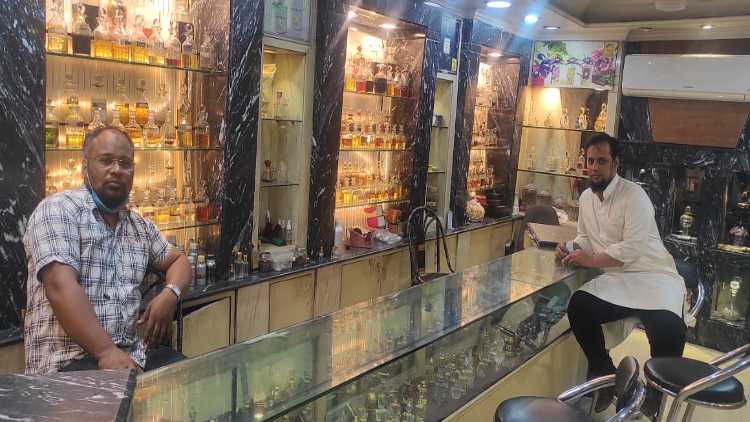
Ratna Chotrani/Hyderabad
Amidst the hustle and bustle of famous Mozzamjahi market , one can never miss the old fashioned but in sync with time perfume shops that line up the busy Hyderabad junction. One definitely cannot miss the traditional perfumeries that are run by the second or perhaps the third generations today.
It’s common to see people specially men emerging from one of the four-five odd mirror-lined ittar shops smelling their fingers.
The ongoing holy month of Ramazan is the most lucrative season for Hyderabad’s famous ittar market that has a rough turnover of a few hundred crores.
There’s never been a French brand Chloé: Absolu de Parfum, or Britain's Jo Malone or even the fashionable Yves Saint Laurent to compete with India’s very own Mughal fragrances whether it is Oudh or Gulab or Mogra. Many widely travelled Indians may pick these foreign fragrances at the duty free shops but when it comes to festivities or weddings, most prefer the fragrance of traditional ittar. Oudh however is the cherished fragrance and also known as liquid Gold in the Arab world. Oudh’s allure has finally percolated shelves, stores and the olfactory notes of beauty brands across the globe.
Saad Bin Mahfouz, owner of the store BinMehfooz, says he has inherited this business from his ancestors and the popularity of this centuries old product remains intact.
Customers throng their shop during festivities never mind the exorbitant price of Ruh-e-Gulab which costs Rs. 10,000 a tola (10 gram) or the equally expensive Vitriver (khus).
During the Nizam era desi ittar was the flavor but gradually the customers preferences changed and most of them now seek foreign brands like Burberry Givenchy L’Interdit Dolce and Gabbana K and the likes
Not to be left behind by competition, ittarwallas also started experimenting with chemicals mixing ittars with base mixture to get the French fragrance.
During the Nizam era dabbing ittar was a luxury and only meant for the Royals. However, today ittar has become the mainstay with every household in the region.
Saad Bin Mahfouz says Oudh ittar is the most exotic fragrance prepared from the extracts of Aquilaria or (Agar) tree .Similarly Sandalwood is used in many fragrances for ittar making .Shamama , Khus , Mogra , Zafran ,Gulab , Janat- Ul- Firdaus have a rich heritage and are the most sought after fragrances.
These are made from the extracts of flowers sourced from different parts of the country like Rajasthan and Uttar Pradesh.
In a world full of scents that are floral, fruity or fresh, oudh brings a totally different flavour that is woody, animalistic, leathery and earthy.
A new palette to target spicy fragrances are those that are extracts of saffron while woody is the khus ki jad , Sandal oil .The citrus fragrances are normally extracts of flowers like jasmine, Rose, chameli, Nargis and Juhi and these are the most popular. In the category of leathery are the extracts like Musk. The most popular fragrance is the gilli mitti or the wet earth that is ethereal the fragrance of first rain on parched earth. It is a scent that evokes memories of rain-laden grey skies, cool fertile mud and washed clay pots.
Oudh is called ‘liquid gold’ in the Arab world as it is a rare commodity. The making of oudh requires precision and knowledge. Oudh oil occurs in the Aquilaria trees that are native to specific regions of South East Asia (in India, the trees are found in the north east).
Oudh has an emotion that this heady scent triggers is big enough reason why every woman needs an oudh in her life right now.
ittars are generally classified based on their perceived effect on the body. ‘Warm’ ittars such as musk, amber and Kesar (saffron) are used in winter, as they are believed to increase body temperature.
Likewise, ‘cool‘ ittars such as Rose, Jasmine, Khus, Kewda and Mogra are used in summers for their perceived cooling effect on the body. Shamama, Khush, Mogra, Genda, Zafran, Rose and Janat-ul- Firdaus all have a rich heritage and are of premium quality, though they cost around 40 per cent less than Oudh and are the most sought after. These are also made from the extract of botanical ingredients sourced from different parts of the country.
It may be rare to get the original stuff today as most fragrances sold in the markets are chemical based but not so with Bin Mahfouz.
Saad Bin Mahfouz says they believe in making quality fragrances with pure Indian ingredients. He says they do not use any chemicals but pure essential oils like sandal oil to blend.
“It’s a challenge to constantly innovate as per demand,” says Berket, owner of Berket and Sons, who says “it’s okay to produce chemical based fragrances for those are in demand.”
Berket says ittar have permanent shelf life and the ones made from original herb extracts smell better as they get old.
Md.Saad Bin Mahfooz explains the ancient technique ofIttar making. It starts with the plucking of flowers early morning. The petals are mixed with water and poured into copper stills known asdeg and sealed with a mixture of clay and cotton. A bamboo pipe doubling as a condenser (chonga) connects the deg to the copper receiver (its mouth is covered with cloth or a lid) placed in a cooling chamber filled with water.
An earthen oven fuelled by wood and dung cakes ‘cooks’ the petals until the distillate is obtained from the vapour in two separate rounds. Both thebhatti and the water in the cooling tank are constantly monitored to maintain an even temperature.
We can recreate most of the French, Italian and American scents with the help of the local ingredients because the base note is more or less the same,” he claims.
At Berket, however, they don’t believe in use of chemicals but pure essential oils which are diluted only depending on costs. They use solvents like sandal oil as a blender.
